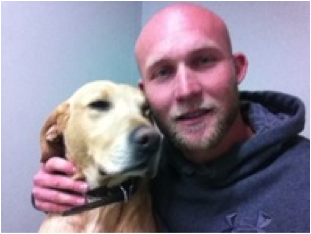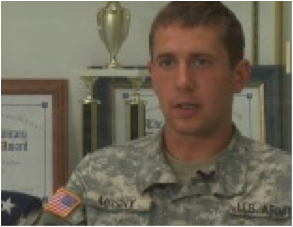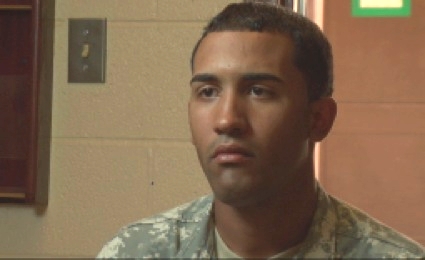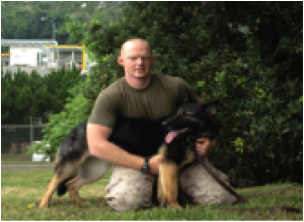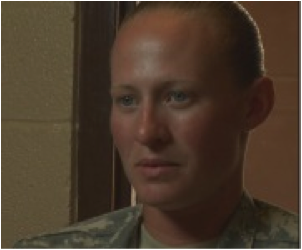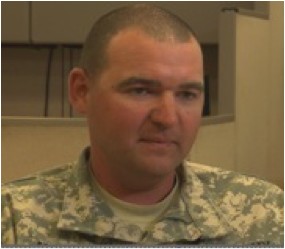Soldiers
Sgt Tyler Budge with MWD BACO, a 7-yr-old German Short Haired Pointer
Sgt Budge describes the turning point when he decided to become a dog handler on patrol during his first deployment to Afghanistan. The SSD dog leading their patrol alerted the unit to a bomb buried underground in a water pipe line while they were preparing to plug up the pipe. As per training the dog stopped at the site and “indicated” by sitting silently at a distance of five feet from the lethal spot. Tyler’s biggest fear about deployment is that Baco could be kidnapped or killed by the enemy. “Baco and I are tight. He is my best friend. I would rather die than anything happen to him.”
SSgt Elizabeth Davies with MWD MAYA, a 3-yr-old Belgian Malinois
Ssgt. Davies won the Top Dog award at the end of three months at SSD Handler School at Lackland Air Force Base. We filmed her during her last two weeks of training in Yuma, Arizona that involves, among other ordeals, searching for a hidden bomb within a 40-acre radius in a sun baked desert. Naturally talented and on her way to becoming a Master Dog Handler, SSgt Davis and her dog Maya, move effortlessly over the rough desert terrain. SSgt Davis’ body language resembles more of an elaborate pas de deux than the routine of a dog handler in control of her dog. When asked what she fears most, she answered, “Not finding a bomb and it’s right there, and then find out that someone was on that same route, that same area, and got killed.”
Sgt Marcin RadwIn and MWD Dex, a 4-yr-old Yellow Lab
“I’m up front with Dex, making sure that the guys behind me don’t step into anything that could potentially threaten their life. When we were coming back from a firefight, insurgents took advantage of it, and placed an IED in the road so our commander vehicle, got blown up. And while we searched around it, we found a second cache of explosives. That’s what they use a lot, thinking that we’ll rush to aid our injured bodies and step into another bomb.”
At the end of his deployment, Radwin worries that Dex will experience separation anxiety and will lick his paws until he get sores. “I go on with my life but he just sits and stares at four walls.” At the end of the film Radwin returns to be a father to his young daughter Ivy rather than re-enlist, acknowledging that because of Dex he is alive to carry on with his human family.
Sgt Brad Mrsny with MWD PACO, a 4-yr-old Belgian Malinois
“The Taliban will put a bounty on a dog’s head, so their prime target is the dog first and then the handler second.” Dog teams work off leash for the added safety of the handler and the troops they lead. “There is always a nervous factor – what if he turns a corner and he gets shot? What if he turns a corner and there are cattle and he decides to go chase it? What if he is all the way up there and he gets shot and we get pinned down, and I can’t get to him to save his life?” Throughout the year MWD Paco found 18 hidden explosives. Paco was hit and got two pieces of shrapnel in his right side. He received a purple heart for his sacrifice.
SSgt Copeland with Baz, an 8-yr-old german shepherd
SSgt Copeland remarks, “You have to be very creative in this job... You have to put yourself in the mind of a criminal, and learn to think like them. Where would I place a bomb, how would I do it, and how can I outsmart the enemy and keep my unit safe.”
An experienced MWD handler, SSgt Copeland must be able to read his dogs’ body language and behavior and to nurture an understanding between the pair usinglanguage that employs verbal commands, hand signals, body movement, and a keen perception of any signs that indicate danger for the dog or the unit. Soldier/handlers must be proficient as both combat soldiers and handlers, able to shoot back and protect themselves and their dog while clearing the route for those behind.
Marine Cpl Peter Coffey with MWD SITA, a 4-yr-old German Shepherd
"I am a Marine, Peter, from North Platte, Nebraska, says, “and it’s all about control. I have to learn to trust her, and let her do her job.” Since dogs are primarily searching for bombs to please their handler and be rewarded with a squeaky toy, he worries that his tendency to control Sita will distract her from her job to work off the leash and search independently.
His relationship with Sita is beginning to change him in ways he could never anticipate, helping him understand the complexity of his relationship with his closest human companion, his wife.
Sgt Hailey Shappard and MWD Tigris, a 5-yr-old black German Shepherd
A former gunner, Sgt Shappard was recently certified as a MWD handler and exceeded everyone’s expectations. She and her dog Tigris scored a remarkable 100% find rate, detecting all of the hidden explosives
She explains her devotion, “Canine is my life. I’m here all the time, including my days off. A lot of our dogs have more character than some humans. Dogs can be more loyal than human beings especially if you build a bond with that specific dog. Maybe your family or friends or coworkers aren’t always going to be there, but your dog will.”
On the one hand, she struggles with the solitude of being a handler: “My biggest fear about deploying with just a dog is not having the camaraderie that you have when you deploy with a company or platoon or a squad, you don't have all those people to fall back on.”
SSgt Joshua Miller, Head Trainer of MWD teams at Fort Hood
One of the most exciting aspects of filming hours of MWD training has been the opportunity to witness the special knowledge a great master trainer passes on to new handlers. By following master trainer SSgt Joshua Miller we see what it takes to build a successful working dog team. Soft spoken when giving instructions and very precise when giving critiques at the end of a long exercises in bomb searching, SSgt Miller resembles more of a Zen master than a military officer.
“A dog and a handler can definitely be in sync together, but there has to be a rapport. The dog is a part of me. When I have it on leash, it is kind of like the movie Avatar. I hook into that dog, and I figure out what he’s doing. And then we work together as a team. It’s a feeling of togetherness. The dog relies on me, and I rely on him. We need each other.” Miller has been working with dogs for 16 years.
sgt danielle jennings with mwd block, a 10-year-old german sheppard
Danielle joined the military and took charge of a unit, and quickly adopted the line mentality: do as you’re told. However in her training as a dog handler, she discovers that this model does not work with dogs. She learns the secret of play to truly bond with her dog. Through this experience, Danielle undergoes a powerful transformation of self from someone who is unable to express herself to someone who is able to have fun. “What other people know how to do, play, have fun, I didn’t know how to do any of that.” In Afghanistan, Danielle and her MWD grow so close that during a firefight he jumps on her back to protect her. “I knew right then that this dog would give his life for me.”
Danielle suffers from PTSD. Block, one of her MWD’s who led her to safety in war, is now poignantly her adopted dog leading her through the healing process. Danielle advocates strongly for giving MWDs a chance to retire and “just be dogs” in their final years.
